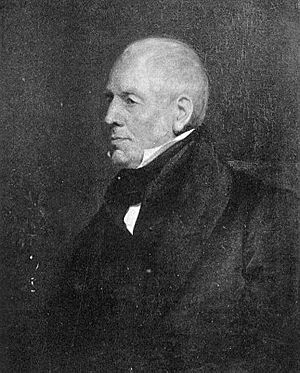Archibald Menzies facts for kids
Archibald Menzies (pronounced MING-iss; born March 15, 1754 – died February 15, 1842) was a Scottish surgeon, botanist, and naturalist. A surgeon is a doctor who performs operations, a botanist studies plants, and a naturalist studies nature. Menzies spent many years at sea, working with the Royal Navy and on important voyages. He was the first European known to reach the top of the Hawaiian volcano Mauna Loa. He also brought the unique Monkey Puzzle tree to England.
Contents
Life and Adventures
Archibald Menzies was born in a place called Easter Stix in Scotland. When he was young, he worked with his older brother at the Royal Botanic Gardens in Edinburgh. There, a professor named Dr. John Hope noticed how good he was with plants. Dr. Hope encouraged Menzies to study medicine at Edinburgh University.
After becoming a qualified surgeon, Menzies worked in Wales. Then, he joined the Royal Navy as an assistant surgeon. He was on a ship called HMS Nonsuch and even took part in a naval battle in 1782. Later, he served in Nova Scotia, Canada.
Voyages and Discoveries
In 1786, Menzies joined a fur-trading trip on a ship called the Prince of Wales. This journey took him around South America, to the northern Pacific Ocean, China, and Hawaii. On this trip, Menzies collected many new types of plants. He also made sure that none of the crew got sick and died, which was a big achievement back then. He returned to Great Britain in 1789. The next year, he became a member of the Linnean Society, a famous group for naturalists.
In 1790, Menzies was chosen to be the naturalist for Captain George Vancouver's voyage around the world. He sailed on HMS Discovery. When the ship's main surgeon became ill, Menzies took over his duties.
Climbing Mauna Loa
In 1794, while the Discovery was in Hawaii, Menzies made an amazing climb. With Lieutenant Joseph Baker and two other men, he became the first European to reach the summit of Mauna Loa. This is a huge volcano in Hawaii. Menzies used a special tool called a barometer to measure the mountain's height. He calculated it to be about 13,564 feet tall. Today, we know it's about 13,679 feet.
It took another 40 years for another European, David Douglas, to reach the top of Mauna Loa.
The Monkey Puzzle Tree
In 1795, Menzies was having dinner with the leader of Chile. For dessert, they were served the seeds of a tree. Menzies secretly put some seeds in his pocket. He managed to grow them on the ship during his journey back to Europe. He arrived in England with five healthy young plants. These were the first Chile Pine trees ever seen in Britain. They later became known as the Monkey Puzzle tree because their spiky leaves were said to be a puzzle for monkeys to climb. These trees became very popular in gardens during the 1800s.
After his long voyage, Menzies continued to serve in the Navy in the Caribbean. He earned a special medical degree in 1799. After leaving the Navy, he became a doctor and surgeon in London. He was also a very important member of the Linnean Society.
Archibald Menzies passed away in London on February 15, 1842, at the age of 87. He is buried in Kensal Green cemetery.
Legacy
Archibald Menzies left behind a lasting legacy. A legacy is something important that a person leaves behind after they are gone. Many plants he discovered were named after him.
- The plant genus Menziesia, which includes several types of shrubs, is named in his honor.
- The famous Douglas fir tree, a very important tree in North America, has the scientific name Pseudotsuga menziesii.
- The Pacific madrone, a large evergreen tree, was named Arbutus menziesii to remember him.
Even a small island in British Columbia, Canada, is called "Bensins Island." This name is a changed version of Menzies' name, used by the local Nuxalk people. The path he used to climb Mauna Loa is still known as "Menzies Trail." Also, a main street in Victoria, British Columbia, is named Menzies Street.
Many of the plant samples Menzies collected are now growing in the famous Kew Gardens in London. He also brought back 112 different collections of artifacts, which are now kept at the British Museum. These collections help us learn about the places he visited and the cultures he encountered.
Images for kids
See also
 In Spanish: Archibald Menzies para niños
In Spanish: Archibald Menzies para niños



